2002 FORD E-250 heater
[x] Cancel search: heaterPage 1 of 256

Introduction 4
Instrument Cluster 10
Warning and control lights 10
Gauges 14
Entertainment Systems 17
AM/FM stereo 17
AM/FM stereo cassette 17
AM/FM stereo cassette with CD 28
AM/FM stereo with CD 36
Climate Controls 70
Heater only 70
Manual heating and air conditioning 71
Lights 76
Headlamps 76
Turn signal control 77
Bulb replacement 79
Driver Controls 84
Windshield wiper/washer control 84
Steering wheel adjustment 85
Power windows 86
Mirrors 87
Speed control (Cruise control) 88
Table of Contents
1
ProCarManuals.com
Page 70 of 256
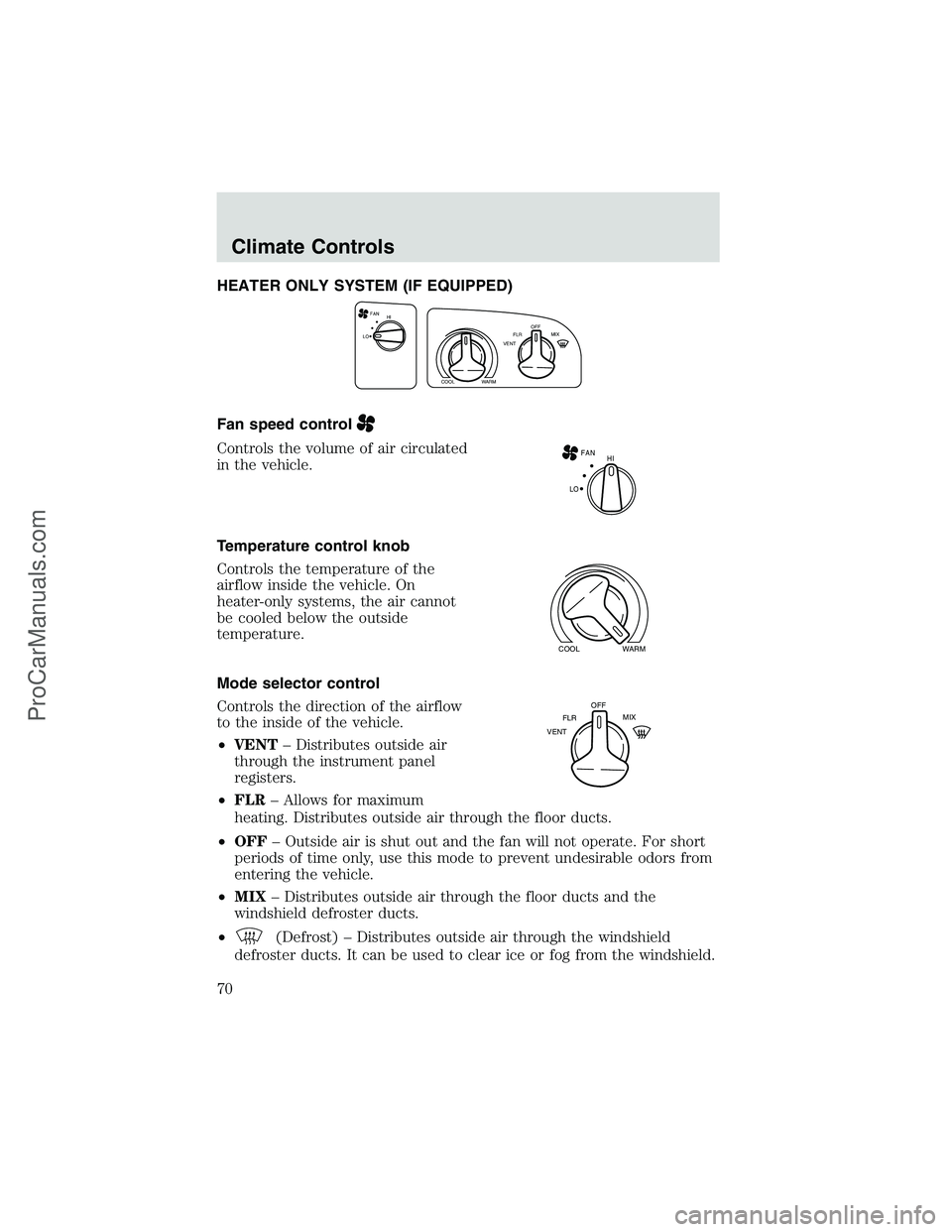
HEATER ONLY SYSTEM (IF EQUIPPED)
Fan speed control
Controls the volume of air circulated
in the vehicle.
Temperature control knob
Controls the temperature of the
airflow inside the vehicle. On
heater-only systems, the air cannot
be cooled below the outside
temperature.
Mode selector control
Controls the direction of the airflow
to the inside of the vehicle.
•VENT–Distributes outside air
through the instrument panel
registers.
•FLR–Allows for maximum
heating. Distributes outside air through the floor ducts.
•OFF–Outside air is shut out and the fan will not operate. For short
periods of time only, use this mode to prevent undesirable odors from
entering the vehicle.
•MIX–Distributes outside air through the floor ducts and the
windshield defroster ducts.
•
(Defrost)–Distributes outside air through the windshield
defroster ducts. It can be used to clear ice or fog from the windshield.
FAN
LOHI
COOLWARM
VENTFLROFF
MIX
FAN
LOHI
COOLWARM
VENTFLROFF
MIX
Climate Controls
70
ProCarManuals.com
Page 75 of 256
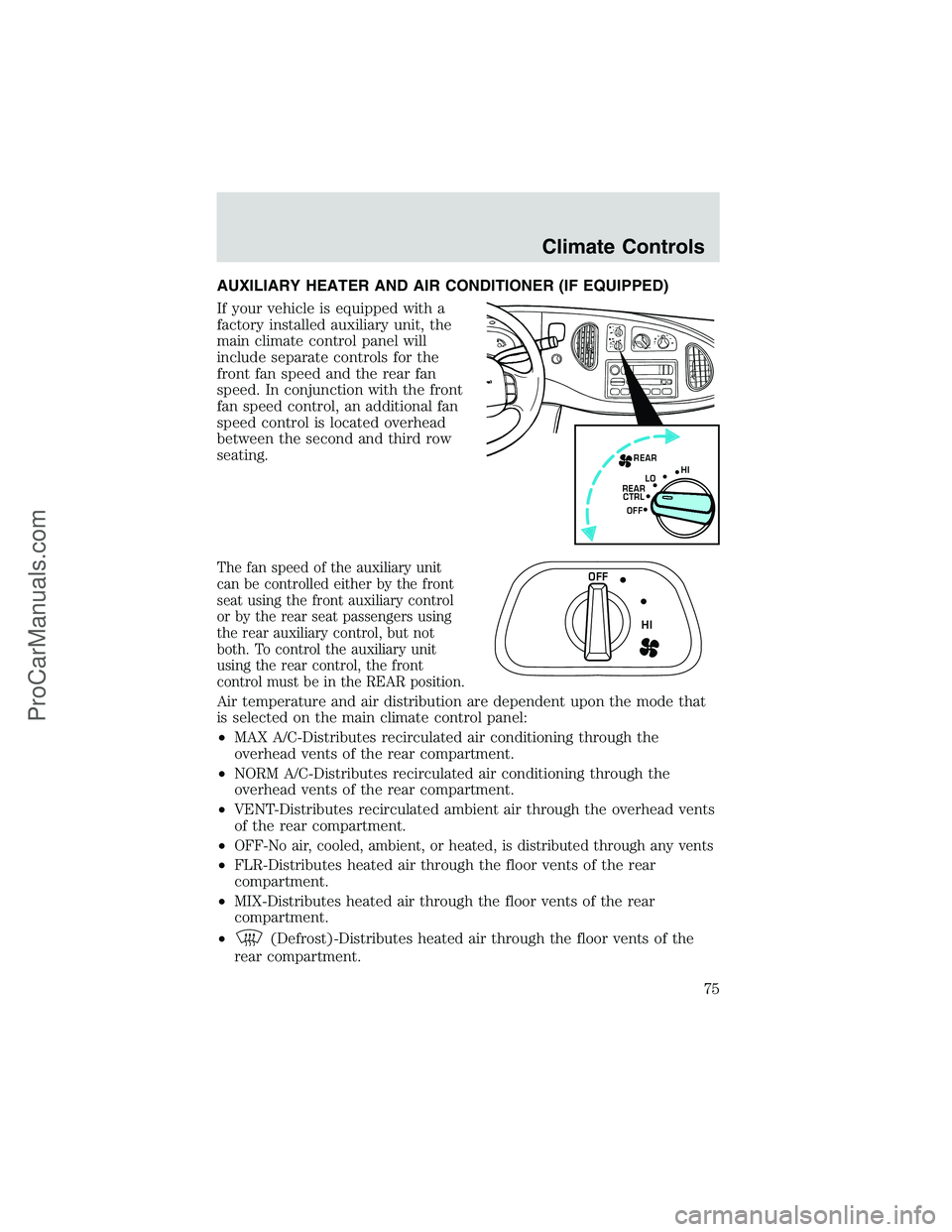
AUXILIARY HEATER AND AIR CONDITIONER (IF EQUIPPED)
If your vehicle is equipped with a
factory installed auxiliary unit, the
main climate control panel will
include separate controls for the
front fan speed and the rear fan
speed. In conjunction with the front
fan speed control, an additional fan
speed control is located overhead
between the second and third row
seating.
The fan speed of the auxiliary unit
can be controlled either by the front
seat using the front auxiliary control
or by the rear seat passengers using
the rear auxiliary control, but not
both. To control the auxiliary unit
using the rear control, the front
control must be in the REAR position.
Air temperature and air distribution are dependent upon the mode that
is selected on the main climate control panel:
•MAX A/C-Distributes recirculated air conditioning through the
overhead vents of the rear compartment.
•NORM A/C-Distributes recirculated air conditioning through the
overhead vents of the rear compartment.
•VENT-Distributes recirculated ambient air through the overhead vents
of the rear compartment.
•
OFF-No air, cooled, ambient, or heated, is distributed through any vents
•FLR-Distributes heated air through the floor vents of the rear
compartment.
•MIX-Distributes heated air through the floor vents of the rear
compartment.
•
(Defrost)-Distributes heated air through the floor vents of the
rear compartment.
REAR
OFF HI
LO
REAR
CTRL
OFF
HI
Climate Controls
75
ProCarManuals.com
Page 139 of 256

1. Turn the key to 5 (START)
without pressing the accelerator
pedal and release as soon as the
engine starts. The key will return to
4 (ON).
2. If the temperature is above–12°
C (10°F) and the engine does not
start within five seconds on the first
try, turn the key to OFF, wait 10
seconds and try again. If the engine
does not start in two attempts,
press the accelerator all the way to the floor and hold. Turn the key to
the START position.
3. If the temperature is below -12°C (10°F) and the engine does not
start in 15 seconds on the first try, turn the key OFF and wait 10
seconds and try again. If the engine does not start in two attempts, press
the accelerator pedal all the way to floor and hold. Turn the key to
START position.
4. When the engine starts, release the key, then release the accelerator
pedal gradually as the engine speeds up.
5. After idling for a few seconds, apply the brake, shift into gear and
drive.
Using the engine block heater (if equipped)
An engine block heater warms the engine coolant, which improves
starting, warms up the engine faster and allows the heater-defroster
system to respond quickly. Use of an engine block heater is strongly
recommended if you live in a region where temperatures reach -23°C
(-10°F) or below.
For best results, plug the heater in at least three hours before starting
the vehicle. Using the heater for longer than three hours will not harm
the engine, so the heater can be plugged in the night before starting the
vehicle.
To prevent electrical shock, do not use your heater with
ungrounded electrical systems or two-pronged (cheater)
adapters.
3
2
1
5
4
Driving
139
ProCarManuals.com
Page 164 of 256

Fuse/Relay
LocationFuse Amp
RatingPassenger Compartment Fuse
Panel Description
5 20A RKE module, Power lock
switches, Memory lock, Power
locks with RKE
6 10A Brake shift interlock, Speed
control, DRL module
7 10A Multi-function switch, Turn signals
8 30A Radio capacitor(s), Ignition coil,
PCM diode, PCM power relay,
Fuel heater (Diesel only), Glow
plug relay (Diesel only)
9 30A Wiper control module, Windshield
wiper motor
10 20A Main light switch, Park lamps,
License lamp (external lamps),
Multi-function switch
(flash-to-pass)
11 15A Brake pressure switch,
Multi-function switch (hazards),
Brake lamp switch, Brake lamps
12 15A Transmission Range (TR) sensor,
Backup lamps, Auxiliary battery
relay
13 15A Blend door actuator, A/C heater,
Function selector switch
14 5A Instrument cluster (air bag and
charge indicator)
15 5A Trailer battery charge relay
16 30A Power seats
17—Not used
18—Not used
19 10A Air bag diagnostic monitor
20 5A Overdrive cancel switch
21 30A Power windows*
22 15A Memory power radio, E-Traveler
radio, E-Traveler console
Roadside Emergencies
164
ProCarManuals.com
Page 176 of 256
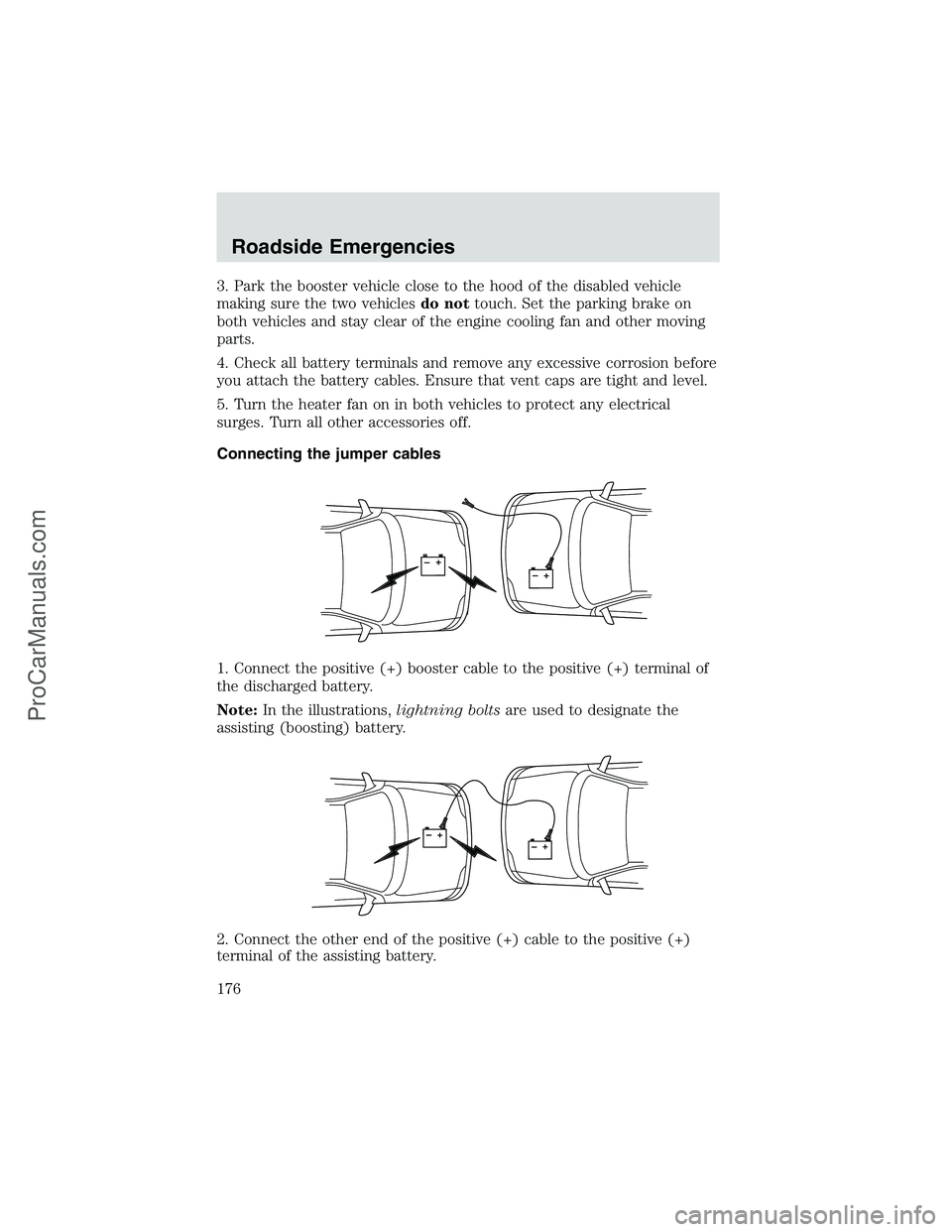
3. Park the booster vehicle close to the hood of the disabled vehicle
making sure the two vehiclesdo nottouch. Set the parking brake on
both vehicles and stay clear of the engine cooling fan and other moving
parts.
4. Check all battery terminals and remove any excessive corrosion before
you attach the battery cables. Ensure that vent caps are tight and level.
5. Turn the heater fan on in both vehicles to protect any electrical
surges. Turn all other accessories off.
Connecting the jumper cables
1. Connect the positive (+) booster cable to the positive (+) terminal of
the discharged battery.
Note:In the illustrations,lightning boltsare used to designate the
assisting (boosting) battery.
2. Connect the other end of the positive (+) cable to the positive (+)
terminal of the assisting battery.
+–+–
+–+–
Roadside Emergencies
176
ProCarManuals.com
Page 248 of 256
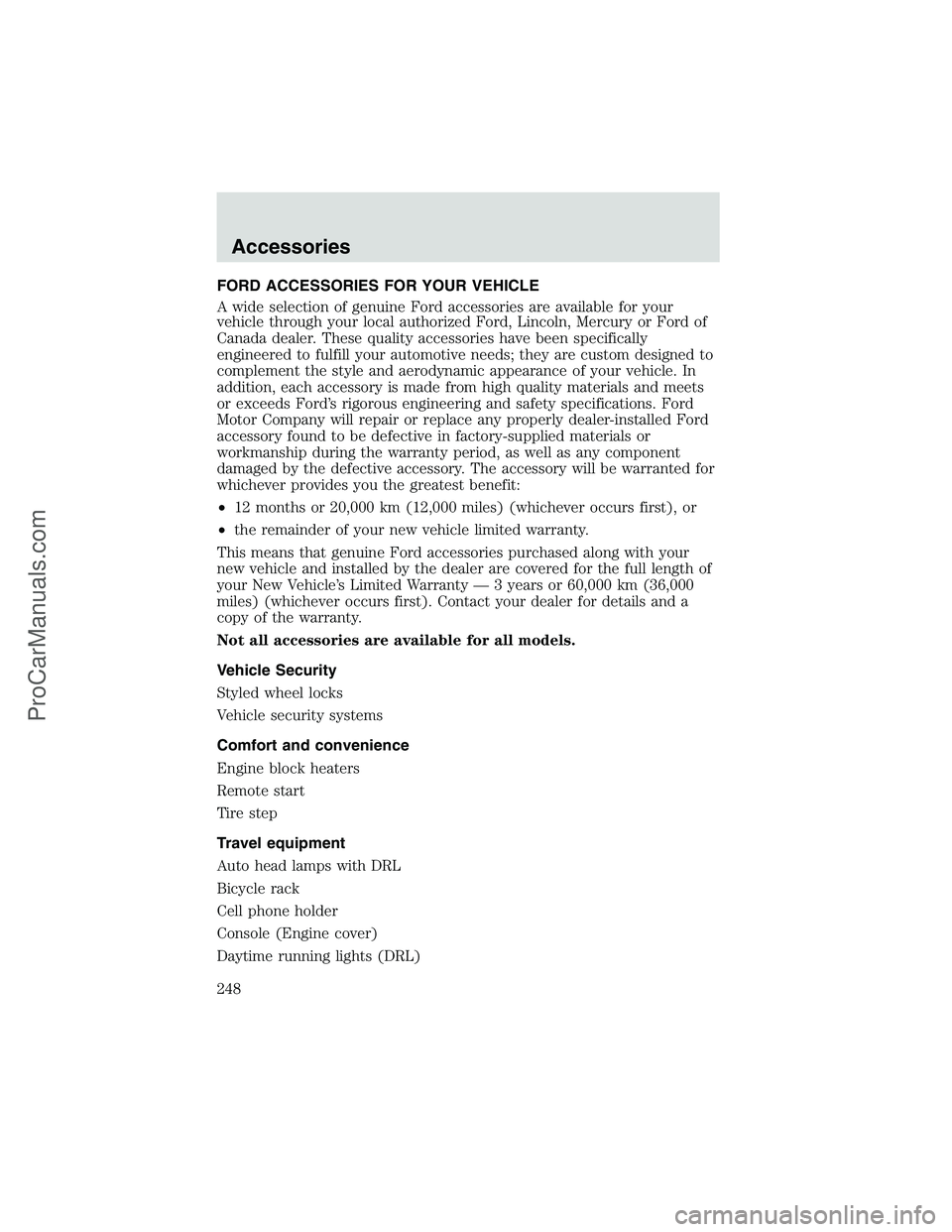
FORD ACCESSORIES FOR YOUR VEHICLE
A wide selection of genuine Ford accessories are available for your
vehicle through your local authorized Ford, Lincoln, Mercury or Ford of
Canada dealer. These quality accessories have been specifically
engineered to fulfill your automotive needs; they are custom designed to
complement the style and aerodynamic appearance of your vehicle. In
addition, each accessory is made from high quality materials and meets
or exceeds Ford’s rigorous engineering and safety specifications. Ford
Motor Company will repair or replace any properly dealer-installed Ford
accessory found to be defective in factory-supplied materials or
workmanship during the warranty period, as well as any component
damaged by the defective accessory. The accessory will be warranted for
whichever provides you the greatest benefit:
•12 months or 20,000 km (12,000 miles) (whichever occurs first), or
•the remainder of your new vehicle limited warranty.
This means that genuine Ford accessories purchased along with your
new vehicle and installed by the dealer are covered for the full length of
your New Vehicle’s Limited Warranty—3 years or 60,000 km (36,000
miles) (whichever occurs first). Contact your dealer for details and a
copy of the warranty.
Not all accessories are available for all models.
Vehicle Security
Styled wheel locks
Vehicle security systems
Comfort and convenience
Engine block heaters
Remote start
Tire step
Travel equipment
Auto head lamps with DRL
Bicycle rack
Cell phone holder
Console (Engine cover)
Daytime running lights (DRL)
Accessories
248
ProCarManuals.com
Page 252 of 256
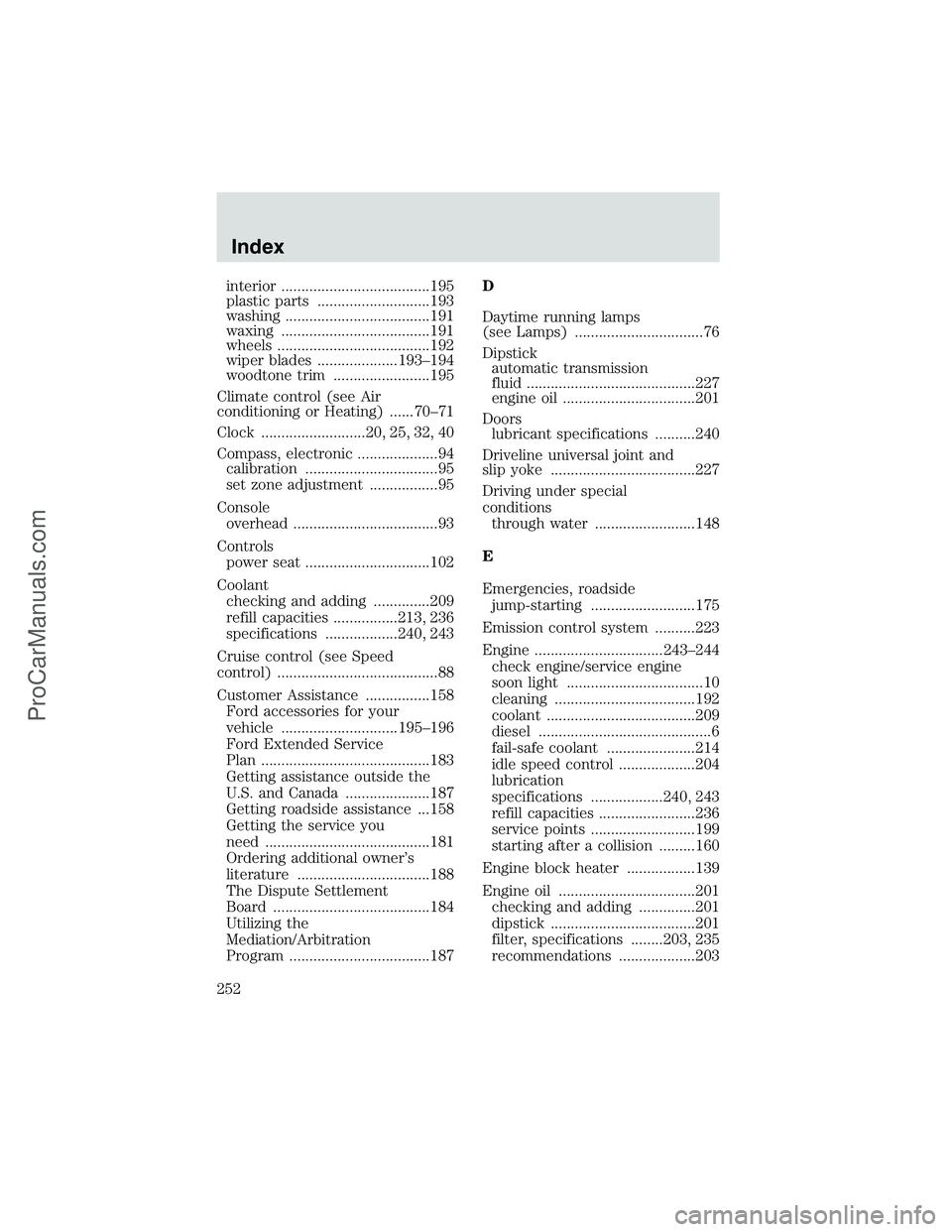
interior .....................................195
plastic parts ............................193
washing ....................................191
waxing .....................................191
wheels ......................................192
wiper blades ....................193–194
woodtone trim ........................195
Climate control (see Air
conditioning or Heating) ......70–71
Clock ..........................20, 25, 32, 40
Compass, electronic ....................94
calibration .................................95
set zone adjustment .................95
Console
overhead ....................................93
Controls
power seat ...............................102
Coolant
checking and adding ..............209
refill capacities ................213, 236
specifications ..................240, 243
Cruise control (see Speed
control) ........................................88
Customer Assistance ................158
Ford accessories for your
vehicle .............................195–196
Ford Extended Service
Plan ..........................................183
Getting assistance outside the
U.S. and Canada .....................187
Getting roadside assistance ...158
Getting the service you
need .........................................181
Ordering additional owner’s
literature .................................188
The Dispute Settlement
Board .......................................184
Utilizing the
Mediation/Arbitration
Program ...................................187D
Daytime running lamps
(see Lamps) ................................76
Dipstick
automatic transmission
fluid ..........................................227
engine oil .................................201
Doors
lubricant specifications ..........240
Driveline universal joint and
slip yoke ....................................227
Driving under special
conditions
through water .........................148
E
Emergencies, roadside
jump-starting ..........................175
Emission control system ..........223
Engine ................................243–244
check engine/service engine
soon light ..................................10
cleaning ...................................192
coolant .....................................209
diesel ...........................................6
fail-safe coolant ......................214
idle speed control ...................204
lubrication
specifications ..................240, 243
refill capacities ........................236
service points ..........................199
starting after a collision .........160
Engine block heater .................139
Engine oil ..................................201
checking and adding ..............201
dipstick ....................................201
filter, specifications ........203, 235
recommendations ...................203
Index
252
ProCarManuals.com